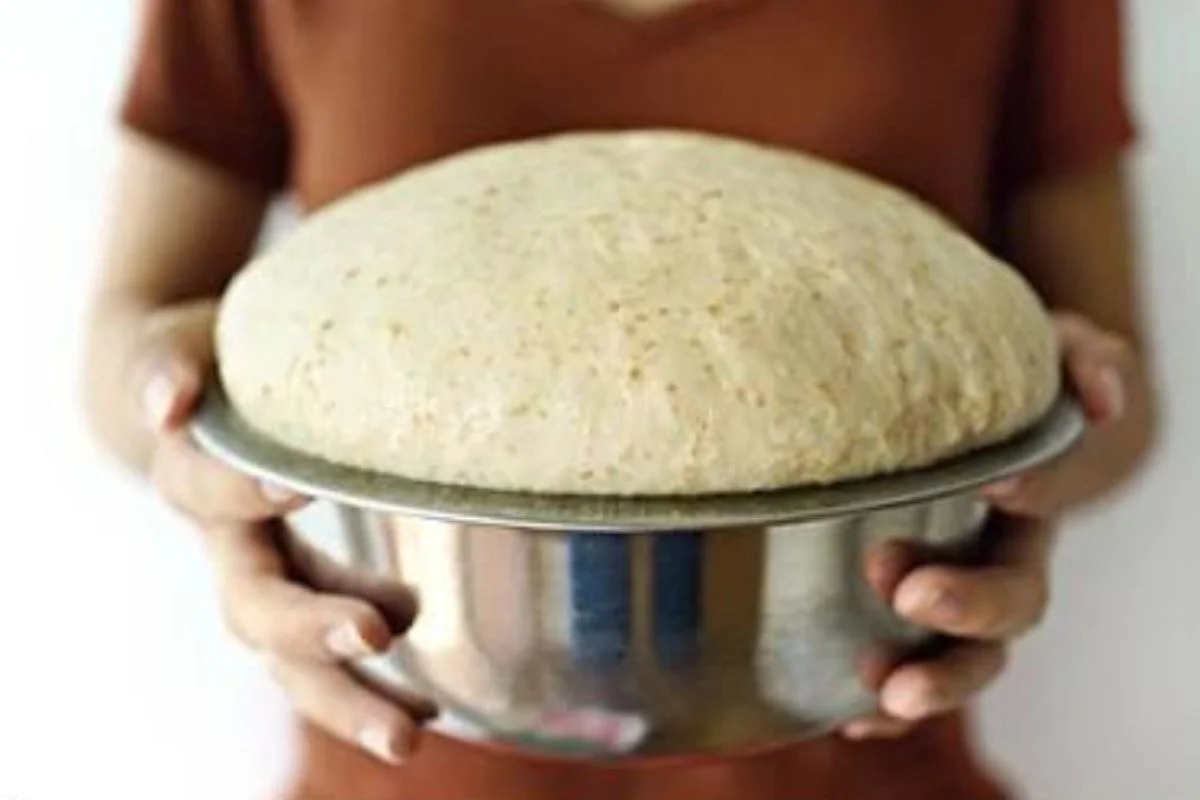
Busting the Myth: Why It’s Safe To Let Your Bread Dough Rise Three Times
Are you a baking enthusiast like me? Have you ever followed the age-old practice of letting your bread dough rise only once? Well, let me tell you a my Experience that changed my bread game forever.
I used to believe that letting the dough rise just once was the only way to achieve a perfect loaf of bread. But one day, a fellow baker shared a secret with me. She told me about the power of triple rising the bread dough. Intrigued, I decided to give it a try.
Contrary to popular belief, triple rising the dough is not only safe but also results in a more delicious outcome. I couldn’t believe it at first, but once I tried it, there was no going back. The triple-rise technique transformed my bread into a lighter, fluffier, and more flavorful masterpiece.
And the best part? I discovered that there were no health risks associated with this method. On the contrary, letting the dough rise multiple times even enhanced its nutritional value. It was a win-win situation!
So, I said goodbye to the one-rising rule and fully embraced the triple-rise technique. My taste buds were beyond grateful. Every bite of my bread was a burst of heavenly flavor, and the texture was simply perfection.
In this article, I will delve deeper into the science behind this baking method. I’ll share why triple rising is a must-try for every bread lover out there. Trust me, once you experience the magic of triple-rise, you’ll never want to go back to the old ways. It’s time to take your bread game to the next level!
Table of Contents
ToggleWhat is Dough Rising?
Before we dive into the reasons behind the myth, let’s briefly touch on what dough rising actually means. Dough rising is a crucial step in bread-making where the yeast ferments the dough, producing carbon dioxide, which causes it to expand and rise. This process gives the bread its airy texture and delightful flavor.
The Myth: Rising Dough Multiple Times is Unsafe
Many home bakers and even some professionals believe that letting bread dough rise more than once can be risky. The concern lies in the potential growth of harmful bacteria during the extended fermentation period. However, this myth is based on misconceptions and misinformation. In reality, when done correctly, allowing your dough to rise multiple times is perfectly safe.
Debunking the Myth: Safety of Letting Dough Rise Three Times
Let’s address the concerns and debunk this myth once and for all. Here’s why it’s safe to let your bread dough rise three times:
- Yeast Activation: Allowing the dough to rise three times actually enhances the yeast activation process. Yeast needs time to fully develop and release its flavor. The additional rising time provides an opportunity for the yeast to ferment and release more complex flavors, resulting in a more delicious loaf of bread.
- Acidity Levels: The extended fermentation time that accompanies multiple rises leads to a decrease in the dough’s pH levels, creating an acidic environment. This acidity inhibits the growth of harmful bacteria and helps ensure the safety of your bread.
- Temperature Control: Proper temperature control during the rising process is essential for bread safety. By following recommended guidelines and maintaining the appropriate temperature, you can minimize any potential risks associated with bacterial growth.
- Hygiene Practices: Maintaining good hygiene practices throughout the bread-making process is crucial. This includes ensuring clean utensils, using fresh ingredients, and proper handwashing. By following these practices, you significantly reduce the risk of contamination and ensure the safety of your bread.
The Benefits of Allowing Bread Dough to Rise Multiple Times
Allowing your bread dough to rise multiple times can have several benefits. Firstly, it can result in a lighter and fluffier loaf with a more open crumb structure. This is because the multiple rises allow the dough to develop more air pockets, which in turn create a lighter texture.
Secondly, multiple rises can enhance the flavor of your bread, as the yeast has more time to ferment and produce more complex flavors.
Lastly, allowing your dough to rise multiple times can actually increase its nutritional value, as the fermentation process breaks down the gluten and makes it more easily digestible.
Another benefit of the triple-rise technique is that it can be used to revive old or dormant sourdough starters. If you have a starter that hasn’t been used in a while, you can revive it by feeding it and letting it rise multiple times before using it in your bread dough. This will help to activate the yeast and bacteria in the starter, resulting in a more flavorful and nutritious loaf.

How to Properly Let Bread Dough Rise Multiple Times
Now that we have a grasp of the science behind bread dough rising, let’s delve into the details of properly letting your dough rise multiple times. The key to achieving success lies in finding the perfect balance between giving the dough enough time to rise and avoiding over-proofing it.
Here is a basic triple-rise technique that can be applied to most bread recipes:
- Start by mixing together all the ingredients for your bread dough and kneading it for a good 5 to 10 minutes. This initial kneading ensures proper gluten development.
- Once the dough is well-kneaded, cover it with a damp cloth or plastic wrap. Allow it to rest for approximately 30 minutes to 1 hour, or until it has roughly doubled in size. This initial rise allows the yeast to activate and begin its fermentation process.
- After the dough has risen sufficiently, gently punch it down to release any excess air. Shape the dough into the desired loaf or any other preferred shape you desire. This step helps to redistribute the yeast and gases within the dough, ensuring an even rise.
- Cover the shaped dough again and let it rest for another 20 to 30 minutes. During this resting period, the dough will rise slightly. This second rise enhances the flavor development and texture of the bread.
- Repeat the shaping and resting process one more time. By doing this, you’re further improving the structure and texture of the bread, giving it an extra boost in lightness and fluffiness.
- Once you have shaped the dough for the final time, allow it to rise one more round until it has almost doubled in size. This last rise will contribute to the final volume and structure of the loaf.
- Now that your dough has gone through its triple rise, it’s time to bake it according to the instructions in your recipe. The result will be a beautifully risen loaf with a delightful flavor profile.
It’s important to bear in mind that the time required for each rise can vary based on the temperature and humidity of your kitchen. Generally, a warmer kitchen will expedite the rising process, while a cooler kitchen will demand longer rising times. Keep an eye on your dough and adjust the resting periods accordingly to achieve optimal results.

Common Mistakes to Avoid When Letting Bread Dough Rise
While letting your bread dough rise multiple times can result in a delicious loaf, there are several common mistakes that can compromise the quality and texture of your bread. Here are some tips to avoid these mistakes:
- Don’t let your dough rise for too long. Allowing the dough to over-proof will lead to a flat, dense loaf with an unpleasant sour taste. Keep a close eye on the rising progress and aim for the dough to double in size, but not exceed that point.
- Don’t skimp on the resting times between rises. These resting periods are vital for the gluten network to relax, allowing the dough to become more pliable and easier to work with. It also aids in the development of desirable air pockets that contribute to a lighter texture.
- Avoid over-kneading your dough. While kneading is essential for gluten development, overdoing it can result in a tough, chewy loaf. Pay attention to the dough’s texture and elasticity, and stop kneading once it reaches a smooth and slightly springy consistency.
- Ensure your ingredients are not too cold. Cold ingredients can hinder yeast activity, leading to slower rises. It is recommended to use ingredients at room temperature, allowing the yeast to activate and ferment the dough optimally. Plan ahead and take your ingredients out of the refrigerator in advance.
Delicious Bread Recipes That Require Multiple Rises
Now that you’re ready to try the triple-rise technique, why not experiment with some delicious bread recipes that require multiple rises? Here are a few recipes to get you started:
Sourdough bread: This classic bread recipe requires a long fermentation process, which can be achieved by letting the dough rise multiple times.
Ciabatta bread: This Italian bread is known for its airy texture and large air pockets, which are created by letting the dough rise multiple times.
Challah bread: This Jewish bread is traditionally braided and requires multiple rises to achieve its light, fluffy texture.
(FAQS) About Letting Dough Rise Three Times
To address any remaining concerns you may have, let’s answer some frequently asked questions about letting dough rise three times:
Can I refrigerate the dough during the rising process?
Absolutely! Refrigerating the dough during the rising process is a common practice known as “retarding.” It slows down the fermentation and allows you to control the timing of your bread-making. Just make sure to cover the dough adequately to prevent it from drying out.
How can I ensure my dough rises properly?
Proper rising relies on a warm, draft-free environment. You can create an ideal rising environment by placing the dough in a lightly greased bowl, covering it with a clean kitchen towel, and leaving it in a warm spot in your kitchen. Alternatively, you can use a proofing box or an oven with the pilot light on.
Can I let the dough rise for more than three times?
Absolutely! While this article focuses on three rises, you can let your dough rise more if you desire. Just ensure that you maintain proper temperature control and follow good hygiene practices throughout.
What are some troubleshooting tips if my bread doesn’t rise properly?
If your bread doesn’t rise properly, several factors could be at play. Check the freshness of your yeast, ensure your dough isn’t too dry or too wet, and verify that your rising environment is warm enough. You can also experiment with adjusting the fermentation time or using different types of yeast to achieve the desired rise.
Can I use this method for any type of bread?
Yes! This method of letting dough rise three times can be applied to various types of bread, including artisan loaves, sandwich bread, and even pizza dough. The benefits of enhanced flavor and texture apply across the board.
Debunking Other Common Bread Myths
Now that we’ve busted the myth of only allowing bread dough to rise once, let’s take a look at some other common bread myths that need debunking:
Myth: Salt kills yeast.
Fact: It is a common misconception that salt kills yeast. The truth is that salt can slow down yeast activity, but it does not actually kill it. In fact, salt plays a crucial role in bread baking. It enhances flavor, helps control fermentation, and contributes to the desired texture and structure of the bread.
Myth: You need a bread machine to make good bread.
Fact: While bread machines can be a convenient tool for making bread, they are by no means necessary for creating delicious bread. All you truly need are a few simple ingredients, like flour, water, yeast, and salt, along with some basic techniques such as mixing, kneading, and shaping. These can be easily accomplished by hand or with the help of a stand mixer.
Myth: You need a lot of kneading to develop gluten.
Fact: While kneading is a traditional method for developing gluten in bread dough, it is not the only way. Alternative techniques, such as stretch and fold, can also effectively develop gluten. These methods involve gently stretching the dough and folding it onto itself, promoting gluten formation without the need for extensive kneading. It’s a great option for those who prefer a less hands-on approach or have physical limitations.
What Happens When You Don’t Let Dough Rise?
Making bread is all about a crucial step: letting the dough rise, and you shouldn’t skip it. When you ignore or speed through this important part, you’re missing out on the magic that turns basic ingredients into a tasty loaf. So, what goes wrong if you don’t let your dough rise properly?
First and foremost, if you skip the rising process, you’ll end up with a heavy and dense bread. Proper rising gives the yeast time to work its magic, producing carbon dioxide that creates those nice, airy pockets in your bread. Without this expansion, your bread will be compact and not as appealing.
What’s more, the flavor and texture will suffer. The slow fermentation during rising brings out rich flavors and a pleasing crumb structure. When you rush it, your bread can taste dull and have an unappealing texture.
Why It’s Safe To Let Your Bread Dough Rise Three Times | Conclusion
Busting the myth that it’s unsafe or unnecessary to let your bread dough rise three times has been a delightful journey. We’ve explored the safety aspects, the benefits, and answered some common questions surrounding this topic.
So, the next time you embark on a bread-making adventure, don’t hesitate to let your dough rise multiple times. Embrace the process, enjoy the enhanced flavors, and savor the satisfaction of creating a delicious homemade loaf. Happy baking!
Lindsey Mackenzie
About me
Hi there! I’m Lindsey Mackenzie, the founder of Bake Smartly. Baking has been my passion since childhood, growing up in my father’s bakery. With Bake Smartly, I’m excited to share my love for all things sweet and savory. Join me on this delicious journey as we whip up scrumptious treats and sprinkle joy into every bite!






